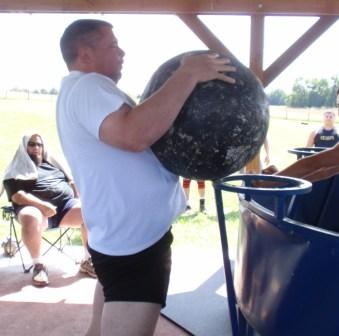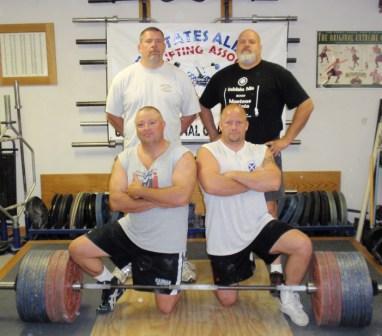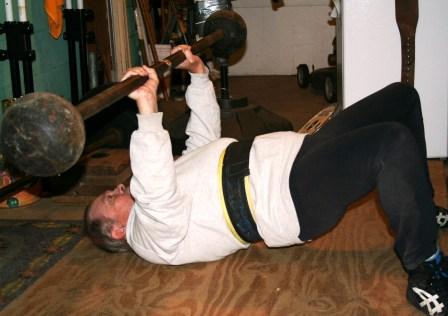Is The IAWA Age Adjustment Fair??
by Al Myers
A topic that will be discussed at this year’s World Meeting at the World Championship will be the age adjustment. This was brought up last year and an IAWA committee was formed to investigate it and present a recommendation to the meeting this year. The membership will be called on to vote on this, whether to make a change or keep things as they are.
This subject is very interesting to me as I hear arguments from both sides. Young lifters think the older lifters get too much adjustment, while the older lifters don’t feel like they get enough. Formulas are always hard to develop and make completely fair as there are so many variables to consider.
I did a study of my own on three lifts. I want to emphasize THIS IS NOT THE IAWA STUDY. It is merely a study which I did to satisfy my own curiosity on this subject. I think it is important that I have this information in hand in order to make an informative vote. I just collected some numbers and did a few calculations. I am not doing this to try to “sway votes” one way or the other. I just wanted to see what “the numbers” really show in regard to decreased lifting performance with age.
Objective: To collect information from age group USAWA records, make USAWA and IAWA(UK) age corrections for comparison, and determine what correction for age group records are needed in order for the age group records to be the same as the overall records.
Design: I collected information from age group USAWA records in three lifts – Bench Press Feet in Air, Hack Lift, and the Zercher Lift. I picked these three lifts for these reasons: they evaluate all areas of overall strength -pressing, pulling and squatting, and the data base for these records was full in regard to records in all weight classes and age divisions. I calculated an average of all weight class records within an age group so bodyweight adjustments would not be a factor in this study. I utilized this formula to determine what correction is needed in order to adjust to the average of the Overall Record.
Assumptions: I used the USAWA and IAWA(UK) age correction for the top age of each division despite the record may have been set a younger age within the division. The record list does not provide that data.
Results:
All Records listed in pounds.
| Age Group |
Overall Record |
USAWA Correction |
IAWA(UK) Correction |
Correction Needed |
| Overall | 353 | 353 | 353 | 0% |
| 40-44 | 280 | 294 | 305 | 26.1% |
| 45-49 | 268 | 295 | 306 | 31.7% |
| 50-54 | 246 | 283 | 293 | 43.5% |
| 55-59 | 228 | 274 | 274 | 54.8% |
| 60-64 | 209 | 261 | 270 | 68.9% |
| 65-69 | 194 | 252 | 268 | 82.0% |
| 70-74 | 167 | 225 | 247 | 111.4% |
| 75-79 | 141 | 197 | 223 | 150.4% |
| 80-84 | 116 | 168 | 195 | 204.3% |
| Age Group |
Overall Record |
USAWA Correction |
IAWA(UK) Correction |
Correction Needed |
| Overall | 538 | 538 | 538 | 0% |
| 40-44 | 465 | 488 | 507 | 15.7% |
| 45-49 | 401 | 441 | 457 | 34.2% |
| 50-54 | 382 | 439 | 455 | 40.8% |
| 55-59 | 330 | 396 | 409 | 63.0% |
| 60-64 | 320 | 400 | 413 | 68.1% |
| 65-69 | 321 | 417 | 443 | 67.6% |
| 70-74 | 304 | 410 | 450 | 77.0% |
| 75-79 | 242 | 339 | 382 | 122.3% |
| 80-84 | 168 | 244 | 282 | 220.2% |
| Age Group |
Overall Record |
USAWA Correction |
IAWA(UK) Correction |
Correction Needed |
| Overall | 452 | 452 | 452 | 0% |
| 40-44 | 372 | 391 | 405 | 21.5% |
| 45-49 | 352 | 387 | 401 | 28.4% |
| 50-54 | 339 | 390 | 403 | 33.3% |
| 55-59 | 331 | 397 | 410 | 36.6% |
| 60-64 | 296 | 370 | 382 | 52.7% |
| 65-69 | 280 | 364 | 386 | 61.4% |
| 70-74 | 246 | 332 | 364 | 83.7% |
| 75-79 | 204 | 286 | 322 | 121.6% |
| 80-84 | 180 | 261 | 302 | 151.1% |
Summary:
| Age Group |
USAWA Correction |
IAWA(UK) Correction |
Data Range |
Data Average |
| Overall | 0% | 0% | 0% | 0% |
| 40-44 | 5% | 9% | 15.7% – 26.1% | 21.1% |
| 45-49 | 10% | 14% | 28.4% – 34.2% |
31.4% |
| 50-54 | 15% | 19% | 33.3% – 43.5% |
39.2% |
| 55-59 | 20% | 24% | 36.6% – 63.0% |
51.5% |
| 60-64 | 25% | 29% | 52.7% – 68.9% |
63.2% |
| 65-69 | 30% | 38% | 61.4% – 82.0% |
70.3% |
| 70-74 |
35% | 48% | 77.0% – 111.4% |
90.7% |
| 75-79 | 40% | 58% | 121.6% – 150.4% |
131.4% |
| 80-84 | 45% | 68% | 151.1% – 220.2% |
191.8% |
As you can clearly see, the USAWA and the IAWA(UK) age corrections do not keep up with the performance decrease with increased age for these three lifts that where selected from the USAWA Record List. No calculations were done to determine the statistical significance of this study.


